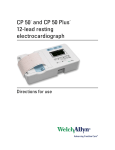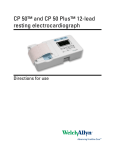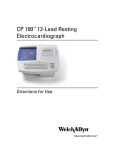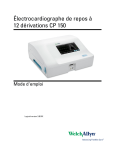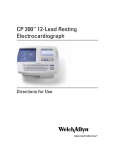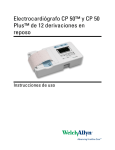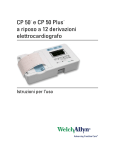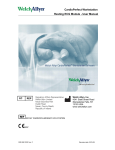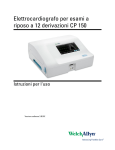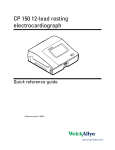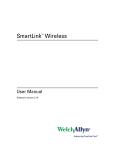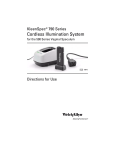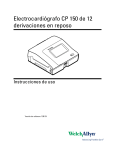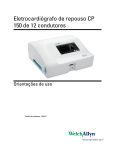Download CP150 Resting Electrocardiograph, Software Version
Transcript
CP 150 12-lead resting electrocardiograph Directions for use © 2013 Welch Allyn, Inc. To support the intended use of the product described in this publication, the purchaser of the product is permitted to copy this publication, for internal distribution only, from the media provided by Welch Allyn. Caution: Federal US law restricts sale of the device identified in this manual to, or on the order of, a licensed physician. Welch Allyn assumes no responsibility for any injury, or for any illegal or improper use of the product, that may result from failure to use this product in accordance with the instructions, cautions, warnings, or indications for use published in this manual. Welch Allyn is a registered trademark of Welch Allyn, Inc. CP 150, and CardioPerfect are trademarks of Welch Allyn, Inc. Patent information For patent information, please visit www.welchallyn.com/patents. Software in this product is copyright Welch Allyn or its vendors. All rights are reserved. The software is protected by United States of America copyright laws and international treaty provisions applicable worldwide. Under such laws, the licensee is entitled to use the copy of the software incorporated within this instrument as intended in the operation of the product in which it is embedded. The software may not be copied, decompiled, reverse-engineered, disassembled or otherwise reduced to human-perceivable form. This is not a sale of the software or any copy of the software; all right, title and ownership of the software remains with Welch Allyn or its vendors. Welch Allyn Technical Support: http://www.welchallyn.com/about/company/locations.htm 105325 (CD) DIR 80018069 Ver. A 105313 (printed copy) Material Number 720134, DIR 80018069 Ver. A Regulatory Affairs Representative Welch Allyn 4341 State Street Road Welch Allyn Limited Skaneateles Falls, NY 13153-0220 U.S.A Dublin Road www.welchallyn.com Navan Business Park Navan, County Meath Republic of Ireland iii Contents Introduction ............................................................................................. 1 About this document ........................................................................................... 1 Intended use ........................................................................................................ 1 Indications for use ................................................................................................ 1 Contraindications ................................................................................................. 1 Description ........................................................................................................... 2 Features ............................................................................................................... 2 Controls, indicators, and connectors .................................................................... 3 Symbols ............................................................................................................... 5 General warnings ................................................................................................. 7 General cautions .................................................................................................. 9 Setup ...................................................................................................... 11 Connecting the patient cable ............................................................................. 11 Loading the thermal paper ................................................................................. 11 Powering the electrocardiograph ....................................................................... 12 Verifying proper operation .................................................................................. 12 Connecting to a CardioPerfect workstation ....................................................... 13 To connect to a network-connected workstation via Ethernet cable ................. 13 ECG home screen .................................................................................. 15 ECG home screen .............................................................................................. 15 ECG tests ................................................................................................ 19 Attaching the leads to the patient ...................................................................... 19 Electrode locations ............................................................................................. 21 Viewing electrode placement ............................................................................ 22 Performing an Auto ECG test ............................................................................ 22 Saved tests ............................................................................................. 27 Searching for saved tests .................................................................................. 27 Managing the saved tests .................................................................................. 27 Settings .................................................................................................. 29 Viewing or changing the ECG settings .............................................................. 29 Selecting the device information ....................................................................... 30 Maintenance .......................................................................................... 33 Cleaning the equipment ..................................................................................... 33 Inspecting the equipment .................................................................................. 34 Testing the electrocardiograph .......................................................................... 34 Replacing the battery ......................................................................................... 35 iv Contents CP 150 12-lead resting electrocardiograph Replacing the AC fuses ...................................................................................... 35 Storing the equipment ....................................................................................... 36 Discarding the equipment .................................................................................. 36 Troubleshooting .................................................................................... 37 Lead-quality problems ........................................................................................ 37 System problems ............................................................................................... 40 Limited warranty ................................................................................................ 42 Service policy ..................................................................................................... 43 EMC guidance and manufacturer’s declarations ................................ 45 EMC compliance ................................................................................................ 45 Electromagnetic emissions ................................................................................ 45 Electromagnetic immunity ................................................................................. 46 Electromagnetic immunity ................................................................................. 47 Recommended separation distances between portable and mobile RF communications equipment and the CP 150 electrocardiograph ...................... 48 Specifications ........................................................................................ 49 1 Introduction About this document This document is written for clinical professionals with a working knowledge of medical procedures and terminology required for monitoring cardiac patients. Before using the electrocardiograph for clinical applications — or before setting up, configuring, troubleshooting, or servicing the electrocardiograph — you must read and understand this document and all other information that accompanies the electrocardiograph and related options or accessories. Intended use The Welch Allyn electrocardiography products (subject devices) are intended for use by trained operators in health facilities. The subject devices provide the following diagnostic functions: • Acquiring, viewing, storing, and printing ECG waveforms using ECG front-end modules (patient cables) and associated accessories that provide signal acquisition for up to twelve (12) leads of patient ECG waveforms through surface electrodes adhered to the body. • Using optional algorithms to generate measurements, data presentations, graphical presentations, and interpretative statements on an advisory basis. These are presented for review and interpretation by the clinician based upon knowledge of the patient, the result of physical examination, the ECG tracings, and other clinical findings. Indications for use The electrocardiograph is one of the tools that clinicians use to evaluate, diagnose, and monitor patient cardiac function. The 12-lead ECG interpretive algorithm provides a computer-generated analysis of potential patient cardiac abnormalities which must be confirmed by a physician with other relevant clinical information. Contraindications The electrocardiograph has no known contraindications. 2 Introduction CP 150 12-lead resting electrocardiograph Description • The electrocardiograph allows users to perform 12-lead ECG measurements and analysis. • The electrocardiograph supports STAT, Auto, and Rhythm test types. • The electrocardiograph provides the ability to print test records on an internal printer or external network printer. • The electrocardiograph allows storage of test records in device memory, external storage media, and external software applications. Features Pacemaker detection The software detects the possible presence of a pacemaker. If you confirm that the patient has a pacemaker, the ECG report includes no interpretation, and it indicates that a pacemaker was detected. Automatic ECG interpretation (optional) The optional MEANS interpretation algorithm, developed by the University of Rotterdam in the Netherlands, provides automatic analysis of ECG tests. For more information, see the MEANS Physicians’ Manual or the PEDMEANS Physicians’ Manual on the CD that came with your electrocardiograph. The MEANS algorithm is used for adult patients 18 years and older. The PEDMEANS algorithm is used for pediatric patients from 1 day through 17 years old. CAUTION Check for the presence of a pacemaker before using ECG with interpretation. Directions for use Introduction Controls, indicators, and connectors No. Feature Description 1 LCD screen 800 x 480 pixels color touchscreen provides a graphical user interface. 2 Power switch and LED Power-on/Standby switch. The LED indicates the charging status when connected to AC power: • Green: The battery is charged. • Amber: The battery is charging. 3 Patient cable connector Provides connection for patient cable. 4 Printer Printer provides a printout of patient Auto ECG, Stat ECG, or Rhythm ECG. 3 4 Introduction CP 150 12-lead resting electrocardiograph Back view No. Feature Description 1 Ethernet connector Provides a hardwired connection to the computer network. The LEDs indicate active network status when the ethernet cable is connected to a network. 2 Clients USB USB, type "mini B." Provides connection to an enabled host. 3 Host USB USB, type "A." Provides four host USB connections for optional accessories. 4 Power connection Provides an external AC power connection. 5 AC fuse Provides access to AC fuse. 6 Ground lug (equipotential terminal) Provided for electrical safety testing and as a means for connection of a potential equalization conductor. 7 Battery compartment (behind cover) Houses the Li-ion battery. Directions for use Introduction Symbols Documentation symbols WARNING The warning statements in this manual identify conditions or practices that could lead to illness, injury, or death. Caution The caution statements in this manual identify conditions or practices that could result in damage to the equipment or other property, or loss of data. This definition applies to both yellow and black and white symbols. Consult Directions for Use, Electronic version available at Welchallyn.com, or Hard copy DFU available from Welch Allyn within 7 days. Meets essential requirements of European Medical Device Directive 93/42/EEC. Power symbols Power on/standby (LED off) No AC power is present The battery is absent or faulty (LED green) AC power is present, and battery is charged. (LED amber) AC power is present, and battery is charging. The battery is charged to the indicated level Alternating current Battery is charging Dangerous voltage Battery door Fuse Rechargeable battery Protective earth Nonionizing electromagnetic radiation Equipotential terminal AC input power 5 6 Introduction CP 150 12-lead resting electrocardiograph Connectivity symbols USB Ethernet (RJ-45 ) Shipping, storing, and environment symbols This end up Keep dry Fragile Relative humidity limit Temperature limits Atmospheric air-pressure limits Separate the battery from other disposables for recycling Recycle Separate the device from other disposables for recycling. China RoHS (restriction of hazardous substances) symbols for control of pollution caused by electronic information products. 5-year environment-friendly use period (EFUP) for batteries. 10-year EFUP for the device. For details, see the accompanying documentation. See www.welchallyn.com/weee. Lithium ion battery Miscellaneous symbols Manufacturer Defibrillation-proof Type CF applied parts Reference/Model number Serial number Reorder/Catalog number Batch code Directions for use Introduction Intertek ETL listed 7 Do not reuse General warnings Warnings indicate conditions or practices that could lead to illness, injury, or death. Warnings related to the environment WARNING The power cord is considered the disconnect device for isolating this equipment from supply mains. Do not position the equipment so that it is difficult to reach or disconnect. WARNING To avoid a possible explosion, do not use the electrocardiograph in the presence of flammable anesthetics: mixtures containing air, oxygen, or nitrous oxide. WARNING When transporting the electrocardiograph on a cart, tuck the patient cable away to keep them clear of the wheels and to minimize trip hazards. Warnings related to accessories and other equipment WARNING To avoid the risk of electric shock, this equipment must only be connected to a supply mains with protective earth. WARNING For operator and patient safety, peripheral equipment and accessories that can come in direct patient contact must be in compliance with all appropriate safety, EMC, and regulatory requirements. WARNING All signal input and output (I/O) connectors are intended for connection of only devices complying with IEC 60601-1, or other IEC standards (for example, IEC 60950), as appropriate to the device. Connecting additional devices to the electrocardiograph might increase chassis or patient leakage currents. WARNING The electrocardiograph has not been designed for use with high-frequency (HF) surgical equipment and does not protect against hazards to the patient. WARNING Defective batteries can damage the electrocardiograph. Visually inspect the battery at least monthly, if the battery shows any signs of damage or cracking, it must be replaced immediately and only with a battery approved by Welch Allyn. WARNING Improper disposal of batteries may create an explosion or contamination hazard. Never dispose of batteries in refuse containers. Always recycle batteries according to local regulations. 8 Introduction CP 150 12-lead resting electrocardiograph WARNING All signal input and output (SIP/SOP) connectors should not be contacted by patient directly and indirectly through the user during operation. Warnings related to using the electrocardiograph WARNING No modification of this equipment is allowed. WARNING This device captures and presents data reflecting a patient’s physiological condition. When reviewed by a trained physician or clinician, this data can be useful in determining a diagnosis. However, the data should not be used as a sole means for determining a patient’s diagnosis or prescribing treatment. WARNING To provide CF protection use only accessories approved by Welch Allyn. Visit www.welchallyn.com. The use of any other accessories can result in inaccurate patient data, can damage the equipment, and can void your product warranty. WARNING To avoid serious injury or death, take these precautions during patient defibrillation: • Avoid contact with the electrocardiograph, patient cable, and patient. • Verify that the patient leads are properly connected. • Place defibrillator paddles properly in relation to electrodes. • After defibrillation, pull each patient lead out of the patient cable and inspect the tips for charring (black carbon marks). If there is any charring, the patient cable and individual leads must be replaced. If there is no charring, fully reinsert the leads into the patient cable. (Charring can occur only if a lead is not fully inserted into the patient cable before defibrillation.) WARNING To prevent the spread of infection, take these precautions: • Dispose of single-use components (for example, electrodes) after using them once. • Regularly clean all components that come in contact with patients. • Avoid ECG testing for patients with open, infectious sores. WARNING Avoid positioning any leads or cables so that they could easily trip someone or become wrapped around a patient’s neck. WARNING To ensure safe use of the device, follow the documented maintenance procedures. WARNING Only qualified service personnel should attempt to repair the electrocardiograph. In case of a malfunction, call Technical Support. WARNING Do not perform ST segment analysis on the ECG screen display, since these ECG representations are scaled. Make manual measurements of ECG intervals and magnitudes on printed ECG reports only. WARNING To maintain diagnostic accuracy and to comply with IEC 60601-02-51 and IEC 60601-02-25, do not scale (re size) when sending a saved ECG to an external printer. Directions for use Introduction 9 WARNING To avoid injury, do not touch the print head immediately after printing. It might be hot. General cautions Cautions indicate conditions or practices that could damage the equipment or other property. CAUTION Federal US law restricts sale of the device identified in this manual to, or on the order of, a licensed physician. CAUTION When removing the electrocardiograph from storage, allow it to thermally stabilize to surrounding environmental conditions before using it. CAUTION To prevent possible damage, do not use sharp or hard objects to press the touch screen or the buttons. Only use fingertips. CAUTION Do not expose the patient cable to strong ultraviolet radiation. CAUTION Do not pull or stretch the patient cable. Doing so could result in mechanical or electrical failures. Form the patient cable into a loose loop before storing. CAUTION Avoid positioning the patient cable where it might get pinched, stretched, or stepped on. Otherwise, measurements might no longer be accurate, and repair might be necessary. CAUTION Using the equipotential terminal for anything but grounding purposes may contribute to damage of the device. CAUTION Use only parts and accessories, including thermal paper, that were supplied with the device and available through Welch Allyn. The use of accessories other than those specified may result in degraded performance or unsafe use of this device. CAUTION Portable and mobile RF communications equipment can affect the performance of the electrocardiograph. CAUTION The electrocardiograph meets the Class A requirements of IEC 60601-1-2 regarding incidental emission of radio frequency interference. As such it is suitable for use in commercial grade electrical environments. If the electrocardiograph is used in residential grade electrical environments and you experience incidental interference with other equipment that uses radio frequency signals to operate, minimize the interference. CAUTION Other medical equipment—including but not limited to defibrillators, ultrasound machines, pacemakers, and other stimulators— may be used simultaneously with the electrocardiograph. However, such devices may disturb the electrocardiograph signal. CAUTION The power cord must be disconnected from AC power before cleaning, maintaining, transporting, or servicing. 10 Introduction CP 150 12-lead resting electrocardiograph CAUTION The requirements of AAMI EC11, Section 3.2.7.2, Frequency and Impulse Response, for an impulse triangle waveform may be impacted by up to 5 milliseconds of small amplitude dampened ringing immediately after the impulse when the muscle filter (35 Hz) is turned on or a small amplitude offset when the baseline filter (0.5 Hz) is turned on. These filters, in any combination turned on or off, meet the AAMI requirements. Measurements performed by the optional interpretation algorithm are unaffected by any filter selections. Note The entire patient cable, up to and including the electrodes are considered to be an Applied Part. 11 Setup Connecting the patient cable WARNING Do not allow the conductive parts of the patient cable, electrodes, or associated connections of defibrillation-proof applied parts, including the neutral conductor of the patient cable and electrodes, to come into contact with other conductive parts, including earth ground. Otherwise, an electrical short might result, risking electric shock to patients and damage to the device. WARNING To avoid injury to the patient or damage to the device, never plug patient leads into any other device or wall outlet. WARNING To provide CF protection use only accessories approved by Welch Allyn. Visit www.welchallyn.com. The use of any other accessories can result in inaccurate patient data, can damage the equipment, and can void your product warranty. CAUTION Always connect the patient cable and the leads properly during defibrillation. Otherwise, the connected leads could be damaged. Loading the thermal paper The electrocardiograph prints on z-fold thermal paper. • Store the paper in a cool, dry, dark place. • Do not expose it to bright light or UV sources. • Do not expose it to solvents, adhesives, or cleaning fluids. • Do not store it with vinyls, plastics, or shrink wraps. 12 Setup CP 150 12-lead resting electrocardiograph Powering the electrocardiograph The electrocardiograph runs on AC or battery power. Plug the electrocardiograph into AC power as often as possible so that the built-in charger can keep the battery charged. Regardless of the battery condition, you can use the electrocardiograph whenever it is plugged in. WARNING When you use AC power, always plug the electrocardiograph into a hospital-grade outlet to avoid the risk of shock. WARNING If the integrity of the building’s safety ground is in doubt, operate this device on battery power to avoid the risk of shock. To turn on or turn off Press . Verifying proper operation To ensure the accuracy of test data, you should verify proper operation of the electrocardiograph before it is used for the first time with patients. You should reverify proper operation once a year. Directions for use Setup 13 To verify proper operation 1. Use an ECG simulator to acquire and print a standard 12-lead ECG of known amplitude and rate. 2. Look for the following indications of proper operation: • Printing should be dark and even across the page. • There should be no evidence of print-head dot failure (no printing breaks forming horizontal streaks). • Thermal paper should move smoothly and consistently during printing. • The waveforms should have no distortion or excessive noise. • The amplitude and rate of the waveforms should match the input value from the ECG simulator. • Z-fold thermal paper should stop with perforations near the tear bar, indicating proper cue-sensor operation. 3. If you see any indications of improper operation, contact Welch Allyn Technical Support. Connecting to a CardioPerfect workstation You can connect a electrocardiograph to a Welch Allyn CardioPerfect workstation via USB cable or via Ethernet cable. Software provided in the Connex Software Connectivity Kit is required to communicate with the workstation. After you connect, you can perform several functions from the electrocardiograph, including: • Send ECG tests to the workstation. • Search for patient data in the workstation database. Cables longer than 3 meters have not been verified for use with the electrocardiograph. Do not use cables longer than 3 meters. To connect to a network-connected workstation via Ethernet cable 1. Connect the electrocardiograph to the same network as the workstation. If you need help, consult your network administrator. WARNING To reduce the risk of fire and shock hazards, connect Ethernet cables within the boundaries of a single building. Ethernet cables that span multiple buildings can introduce fire or shock hazards unless fiber optic cables or lightning arrestors are properly installed or other appropriate safety measures are taken. 14 Setup CP 150 12-lead resting electrocardiograph 2. Go to the Network screen a. Touch the Settings tab. b. Touch the Device tab. c. Touch the Network button. 3. Fill in the screen. • If DHCP is enabled for the network, select the DHCP checkbox. • If DHCP is not enabled, fill in the fields: Network IP address, Subnet mask, and Default gateway. 4. Touch the Test with ping button. 5. Connect to the network. a. In the Host Address field, enter the host IP address. b. Touch the Ping Test button. The electrocardiograph pings the host. 6. Choose one of these to specify how to get DCP server IP information: • Obtain server IP information automatically: Select this option if you want the device to get the IP address, or if you don’t know the server’s IP address. • DCP IP address: Fill in this field if your DCP server IP address is available. • Fill in the UDP broadcast port field. 7. Touch Test connection. 8. Fill in the Remote file server address, User ID, and password. 9. Touch Test remote folder. The electrocardiograph connects to the remote file server. The electrocardiograph is ready to send tests to the remote file server. (To set up the workstation, see the instructions that came with the workstation connectivity software. 15 ECG home screen ECG home screen The ECG home screen includes the following areas: Item Area 1 Device status 2 Content 3 Navigation Device status area The Device status area, located at the top of the ECG home screen, displays: • Time and date • Battery status • Error or information messages. These items are displayed until the condition has been resolved. 16 ECG home screen CP 150 12-lead resting electrocardiograph Content area The Content area includes 3 test selection buttons and a preview selection button: • Auto ECG • Rhythm ECG • Stat ECG • Electrode Placement The content area also provides shortcuts to several controls. About the test types Auto ECG A report typically showing a 10-second acquisition of 12 leads of ECG information combined with patient data, measurements, and optional interpretation. Auto ECGs can be saved to the electrocardiograph’s test directory or to a USB mass-storage device. Rhythm ECG A continuous, real-time printout of rhythm strips with a user-defined lead configuration. Rhythm ECGs are printouts only. They cannot be saved. Stat ECG An auto ECG that starts without waiting for you to enter patient data or adjust the waveforms. Navigation area The Navigation area includes the following tabs: • ECG home: Displays ECG test types and provides shortcuts to several controls. • Saved tests: Accesses the patient ECG tests. • Settings: Accesses device configuration settings. To navigate to a tab, touch the tab in the Navigation area with the corresponding name. The active tab is highlighted. Directions for use Example ECG report ECG home screen 17 18 ECG home screen CP 150 12-lead resting electrocardiograph 19 ECG tests Attaching the leads to the patient Proper lead attachment is important for a successful ECG. The most common ECG problems are caused by poor electrode contact and loose leads. Follow your local procedures for attaching the leads to the patient. Here are some common guidelines. WARNING Electrodes can cause allergic reactions. To avoid this, follow the electrode manufacturer’s directions. To attach the leads to the patient 1. Prepare the patient. • Describe the procedure. Explain the importance of holding still during the test. (Movement can create artifact.) • Verify that the patient is comfortable, warm, and relaxed. (Shivering can create artifact.) • Put the patient in a reclining position with the head slightly higher than the heart and legs (the semi-Fowler’s position). 2. Select the electrode locations. (See the “Electrode locations” chart.) • Look for flat areas. • Avoid fatty areas, bony areas, and major muscles. 3. Prepare the electrode locations. • Shave or clip the hair. • Thoroughly clean the skin, and lightly rub it dry. You may use soap and water, isopropyl alcohol, or skin preparation pads. 4. Attach the lead wires to the electrodes. 5. Apply the electrodes to the patient. 20 ECG tests CP 150 12-lead resting electrocardiograph Electrode examples, left to right: arm clamp (reusable), Welsh cup (reusable), tab electrode (disposable), monitoring electrode (disposable). • For reusable electrodes: Use electrode paste, gel, or cream to cover an area the size of each electrode but no larger. Secure the arm and leg clamps. Apply the Welsh cups (suction electrodes) to the chest. • For disposable tab electrodes: Place the electrode tab between the “jaws” of the connector. Keep the tab flat. Verify that the metal portion of the connector makes contact with the skin side of the electrode tab. • For all disposable electrodes: Lightly tug on the connector to ensure that the lead is securely attached. If the electrode comes off, replace it with a new electrode. If the connector comes off, reconnect it. Directions for use ECG tests Electrode locations AHA IEC Location A V1 (red) C1 (red) Fourth intercostal space at the right sternal border. B V2 (yellow) C2 (yellow) Fourth intercostal space at the left sternal border. C V3 (green) C3 (green) Midway between V2 and V4. D V4 (blue) C4 (brown) Fifth intercostal space to the left of the midclavicular line. E V5 (orange) C5 (black) Anterior axillary line at the same horizontal level as V4. F V6 (purple) C6 (purple) Mid-axillary line at the same horizontal level as V4 and V5. G LA (black) L (yellow) Just above the left wrist on the inside of the arm. H LL (red) F (green) Just above the left ankle. I RL (green) N (black) Just above the right ankle. J RA (white) R (red) Just above the right wrist on the inside of the arm. 21 22 ECG tests CP 150 12-lead resting electrocardiograph Viewing electrode placement 1. Touch the (ECG preview) button. The ECG preview screen appears. 2. Touch the (torso) button to enlarge the lead placement image or touch to close it. Performing an Auto ECG test CAUTION Patient data is not saved until the ECG test is completed. Note The ECG configuration settings can be changed in the Settings tab. The following settings may appear differently if the default settings have been modified. 1. Touch the (Auto ECG) button. The Summary tab appears. 2. (Optional) Search for patient. The Search tab gives you access to patient data in the Saved tests directory or in a connected database (CardioPerfect workstation or EMR). • Touch the Search tab. • Enter the Patient ID or Last name. • Touch the OK button. • Touch the Search button. • Touch the patient's name or ID in the Patient Name/Patient ID field. • Touch the Select button. • Touch the (Next) button to review or edit patient information. • Touch the (Next) button again. Skip to step 7. 3. Enter the following patient information as desired: Directions for use ECG tests • Patient ID. Touch the OK button. • Birth date. Touch the OK button. • Last name. Touch the OK button. • First name. Touch the OK button. • Middle Initial. Touch the OK button. Note 4. Touch the If the patient has a pacemaker touch the Pacemaker present button. (Next) button. 5. Enter the following patient information as desired: • Gender • Race • Height. Touch the OK button. • Weight. Touch the OK button. 6. Touch the (Next) button. 7. Attach the leads to the patient. Note If the lead-status screen is closed, touch the button to enlarge the lead-status screen. (torso) Any flashing dots on the lead-status screen indicate unattached or poorly attached leads. When all leads have been attached for several seconds, the ECG preview screen appears. 23 24 ECG tests CP 150 12-lead resting electrocardiograph Item Button 1 Leads button 2 Gain button (size) 3 Speed button 4 Filters button 8. If an Artifact message appears, minimize the artifact, as described under Troubleshooting. You might need to ensure that the patient is comfortably warm, reprepare the patient’s skin, use fresh electrodes, or minimize patient motion. 9. (Optional) Adjust the waveforms, using the buttons to cycle through the following options: • leads displayed • gain (size) • speed • filters 10. Touch the Print button to perform the Auto ECG test. 11. If a Waiting for 10 seconds of quality data message appears, at least 10 seconds of ECG data have been collected with excessive artifact. Time requirements in the message may vary, based upon selected print format. Minimize the artifact, as described under Troubleshooting. Then wait for the test to print. If necessary, you can override the wait time and print the available data immediately, but the result might be an incomplete or poor-quality test. 12. After the test prints, select the desired option: Reprint, Save, or Retest. If the Auto Save setting is turned off, touch Save to save the test. Select one of the following locations: • Local (internal memory) • USB mass storage device (Any tests that you save to a USB mass storage device can be retrieved only from a CardioPerfect workstation.) • Workstation Directions for use ECG tests • 25 Remote file location 13. Touch Reprint to print the test again, touch Retest to discard the test and start over, or touch Exit. WARNING To avoid the risk of associating reports with the wrong patients, make sure that each test identifies the patient. If any report does not identify the patient, write the patient identification information on the report immediately following the ECG test. 26 ECG tests CP 150 12-lead resting electrocardiograph 27 Saved tests Searching for saved tests Search for Saved Tests by: • Date • Last name • Patient ID • Test type ○ All ○ Unconfirmed ○ Unprinted ○ Unsent Once retrieved, Saved Tests can be printed, deleted, edited, or sent to a USB storage device or a Workstation. Managing the saved tests Saved tests are a group of ECG tests that have been saved in the electrocardiograph memory. With all electrocardiograph models, you can delete or print saved tests. You can also do the following: • Edit the patient data in Saved Tests. • Send saved tests to a USB mass-storage device or to a Welch Allyn CardioPerfect workstation. (Any tests that you send to a USB mass-storage device can be retrieved only from a CardioPerfect workstation.) To manage saved tests 1. Touch the Saved tests tab. 2. Enter data into the Date from, Last name, or Patient ID field, or select the check box to search the Test Type for All, Unconfirmed, Unprinted, or Unsent tests. 3. Touch the (Search) button. 4. Select a single test or multiple tests. 5. Touch the Delete, Print, Edit, or Send button to manage the saved tests. 28 Saved tests CP 150 12-lead resting electrocardiograph 29 Settings Viewing or changing the ECG settings • The ECG settings control the content and format of your reports. These settings include a second Auto report format (Auto report) and a Rhythm format (Rhythm report), customizable patient data fields, and auto save options. To view or change the settings 1. Touch the Settings tab. The ECG tab and the vertical ECG configuration tab appear. Modify the settings as desired: Note The following settings are saved as they are selected. • Waveform centering on • Baseline filter on • Muscle filter on • Save reminder on • Default gain • QTc method Touch the (Next) button. Modify the settings as desired: • Electrode labels • Electrode configuration • ECG interval • Lead timing Touch the Rhythm report tab. Modify the settings as desired: • Default speed • Print options Touch the (Next) button. Modify the settings as desired: 30 Settings CP 150 12-lead resting electrocardiograph • Rhythm leads 1 - 12 Touch the Auto report tab. Modify the settings as desired: • Printer • Report format • Average cycles • Rhythm leads 1 - 3 Touch the (Next) button. Modify the settings as desired: • First name • Height • Weight • Race • Middle Initial Select: • Age or Birth date Touch the (Next) button. Modify the settings as desired: • Extended measurements • MEANS reason statements (optional purchase) Selecting the device information To select the device information 1. Touch the Settings tab. The ECG tab appears. 2. Touch the Device tab. The Regional tab appears. Modify the settings as desired: • Date format • Time format • Height ○ cm • ○ ft & in ○ in Weight ○ kg ○ • lb Mains (AC) frequency Directions for use Settings • 31 Language Touch the Device configuration tab. Modify the settings as desired: • Auto save • Data management • LCD brightness • HR beep on • Error beep on • Caps lock on or off • Calibrate Touch the About tab to view: • Device serial number, model, software version, memory, battery charge percentage, etc. Touch the Network tab to view or modify network settings. See To connect to a network-connected workstation via Ethernet cable for further details. If you need help, consult your network administrator. Touch the Ownership tab. Modify the settings as desired: • Practice ID • Device ID • Contact information Touch the Updates tab. • Touch Update to install the latest device software. • Touch Restore to restore factory defaults. • Touch Save configuration to save the device configuration to USB. • Touch Copy configuration to copy the configure from USB. 32 Settings CP 150 12-lead resting electrocardiograph 33 Maintenance Cleaning the equipment WARNING Keep the electrocardiograph, reusable electrodes, and the patient cable clean. Patient contact with contaminated equipment can spread infection. CAUTION Never let soap or water come into contact with the electrocardiograph’s internal printer, connectors, or jacks. CAUTION Never immerse the electrocardiograph or the patient cable in liquid. Never autoclave or steam clean the electrocardiograph or the patient cable. Never pour alcohol directly on the electrocardiograph or the patient cable, and never soak any components in alcohol. If any liquid enters the electrocardiograph, remove the electrocardiograph from service, and have it inspected by a qualified service person before using it again. Note The patient cables should be cleaned after each use. Clean on a routine basis according to your facility's protocols and standards or local regulations. The following agents are compatible with the electrocardiograph: • 70 percent isopropyl alcohol • 10 percent chlorine bleach solution CAUTION When cleaning the device, avoid using cloths or solutions that include quaternary ammonium compounds (ammonium chlorides) or glutaraldehyde-based disinfectants. Note Disinfect according to your facility's protocols and standards or local regulations. To clean the equipment (monthly or more often if needed) 1. Disconnect the power plug from the AC outlet. 34 Maintenance CP 150 12-lead resting electrocardiograph 2. Turn off the electrocardiograph. (Press and hold the power button for at least six seconds until the screen goes blank.) 3. Dampen a cloth with any of the acceptable cleaning solutions, and wipe the exterior of the patient cable and electrocardiograph. Dry all components with a clean, soft cloth, or paper towel. 4. Before you turn on the electrocardiograph again, wait at least 10 minutes for all traces of liquid to evaporate. 70 percent isopropyl alcohol Wipe the electrocardiograph with a clean cloth slightly dampened with 70 percent isopropyl alcohol. 10 percent chlorine bleach solution 1. Wipe the electrocardiograph with a clean cloth slightly dampened with a 10 percent bleach and water solution. Follow the cleaning agent manufacturer's guidelines. 2. Rinse with a clean cloth slightly dampened with water that meets EP and USP quality standards. 3. Allow the electrocardiograph surface to dry for a minimum of 10 minutes before using the electrocardiograph. Inspecting the equipment Perform the following inspections daily. • Check for cracked or broken patient cable, patient electrodes, power cord, communications cables, display, and enclosure. • Check for bent or missing pins on all cables. • Check all cable and cord connections; reseat if any connectors are loose. Testing the electrocardiograph Welch Allyn recommends verifying proper operation of the electrocardiograph once a year to ensure reliability. See Verifying proper operation. Whenever the electrocardiograph is serviced or whenever problems are suspected, verify continued electrical safety of the device using IEC 60601-1 or ANSI/AAMI ES1 methods and limits. WARNING Only qualified service personnel should perform leakage current tests. Test for the following: • Patient leakage current Maintenance Directions for use • Chassis leakage current • Earth leakage current • Dielectric strength (AC and patient circuits) 35 Replacing the battery Replace the battery under these circumstances: • It loses its charge quickly. • You have charged it, and the electrocardiograph still does not turn on when unplugged. The first time that you press the power button after installing a new battery, the electrocardiograph goes through some diagnostic tests that cause it to take longer than usual to power up. Discard the old battery appropriately. Contact your local authorities concerning recycling. To replace the battery Replacing the AC fuses You might need to replace one or both of the AC fuses if the AC power indicator does not light up when the electrocardiograph is connected to AC power. 36 Maintenance CP 150 12-lead resting electrocardiograph WARNING Failure to unplug could result in electrocution. To replace the AC fuses If either fuse is dark or has a broken wire, replace the fuse. Line up the fuse case with the opening; it goes in only one way. Storing the equipment When storing the electrocardiograph, cords, and accessories, observe the environmental storage conditions that are identified in the product specifications. Discarding the equipment Discard the electrocardiograph, cords, and accessories according to local laws. Do not dispose of this product as unsorted municipal waste. Prepare this product for reuse or separate collection as specified by Directive 2002/96/EC of the European parliament and the Council of the European Union on Waste Electronic and Electrical Equipment (WEEE). If this product is contaminated, this directive does not apply. For more specific disposal information, see www.welchallyn.com/weee, or contact Welch Allyn Customer Service at +44 207 365 6780. 37 Troubleshooting Lead-quality problems “Artifact” message on the screen Artifact is signal distortion that makes it difficult to accurately discern the waveform morphology. Causes • The patient was moving. • The patient was shivering. • There is electrical interference. Actions See actions for wandering baseline, muscle tremor, and AC interference. Wandering baseline Wandering baseline is an upward and downward fluctuation of the waveforms. Causes • Electrodes are dirty, corroded, loose, or positioned on bony areas. • The electrode gel is insufficient or dried. • The patient has oily skin or used body lotions. • Rising and falling of chest during rapid or apprehensive breathing. Actions • Clean the patient’s skin with alcohol or acetone. • Reposition or replace the electrodes. • Verify that the patient is comfortable, warm, and relaxed. • If wandering baseline persists, turn the baseline filter on. 38 Troubleshooting CP 150 12-lead resting electrocardiograph Muscle tremor Causes • The patient is uncomfortable, tense, nervous. • The patient is cold and shivering. • The exam bed is too narrow or short to comfortably support arms and legs. • The arm or leg electrode straps are too tight. Actions • Verify that the patient is comfortable, warm, and relaxed. • Check all electrode contacts. • If interference persists, turn the muscle-tremor filter on. If interference still persists, the problem is probably electrical in nature. See the suggestions for reducing AC interference (in a related troubleshooting tip). AC interference AC interference superimposes even-peaked, regular voltage on the waveforms. Causes • The patient or technician was touching an electrode during recording. • The patient was touching a metal part of an exam table or bed. • A lead wire, patient cable, or power cord are broken. • Electrical devices in the immediate area, or lighting, or wiring concealed in walls or floors are interfering. • An electrical outlet is improperly grounded. • The AC filter is turned off or set incorrectly. Actions • Verify that the patient is not touching any metal. • Verify that the AC power cable is not touching the patient cable. • Verify that the proper AC filter is selected. • If interference persists, unplug the electrocardiograph from AC power and run it on the battery. If this solves the problem, you’ll know that the noise was introduced through the power line. • If interference still persists, the noise may be caused by other equipment in the room or by poorly grounded power lines. Try moving to another room. Directions for use Troubleshooting 39 Lead alert or square wave A dot might be flashing on the lead-status screen. Or one or more leads might appear as a square wave. Causes • Electrode contact might be poor. • A lead might be loose. • A lead might be defective. Actions • Replace the electrode. • Verify that the patient’s skin has been properly prepared. • Verify that electrodes have been properly stored and handled. • Replace the patient cable. 40 Troubleshooting CP 150 12-lead resting electrocardiograph System problems The electrocardiograph won't turn on when it is plugged in Causes • The AC power connection is faulty. • An AC fuse is blown. • There is no AC power. Actions • Check the AC power source. • Check the AC fuses. The electrocardiograph won't turn on when it is unplugged Causes • The battery is disconnected or incorrectly connected. • The battery is low, not charging, depleted, or bad. Actions • Check the battery connections. • Recharge the battery. • Replace the battery. The electrocardiograph shuts down during printing Causes • The battery is low or bad. Actions • Recharge the battery. • Replace the battery. The electrocardiograph prints fewer than 10 reports on a full battery charge Causes • The battery is degraded. Actions • Replace the battery. Directions for use Troubleshooting The electrocardiograph does not respond when you press buttons or touch the screen Causes • The electrocardiograph is frozen. Actions • Reset the electrocardiograph by pressing and holding the power button for at least six seconds until the screen goes blank. Press the power button again. The electrocardiograph goes through some diagnostic tests that cause it to take longer than usual to power up. Note For more troubleshooting guidelines, see the service manual. CAUTION The service manual is for use only by qualified service personnel who understand technical English. 41 42 Troubleshooting CP 150 12-lead resting electrocardiograph Limited warranty Welch Allyn warrants the product to be free of defects in material and workmanship and to perform in accordance with manufacturer's specifications for the period of three years from the date of purchase from Welch Allyn or its authorized distributors or agents. The warranty period shall start on the date of purchase. The date of purchase is: 1) the invoiced ship date if the device was purchased directly from Welch Allyn, 2) the date specified during product registration, 3) the date of purchase of the product from a Welch Allyn authorized distributor as documented from a receipt from said distributor. This warranty does not cover damage caused by: 1) handling during shipping, 2) use or maintenance contrary to labeled instructions, 3) alteration or repair by anyone not authorized by Welch Allyn, and 4) accidents. The product warranty is also subject to the following terms and limitations: Accessories are not covered by the warranty. Refer to the directions for use provided with individual accessories for warranty information. Shipping cost to return a device to a Welch Allyn Service center is not included. A service notification number must be obtained from Welch Allyn prior to returning any products or accessories to Welch Allyn's designated service centers for repair. To obtain a service notification number, contact Welch Allyn Technical Support. THIS WARRANTY IS IN LIEU OF ALL OTHER WARRANTIES, EXPRESS OR IMPLIED, INCLUDING BUT NOT LIMITED TO THE IMPLIED WARRANTIES OF MERCHANTABILTY AND FITNESS FOR A PARTICULAR PURPOSE. WELCH ALLYN’S OBLIGATION UNDER THIS WARRANTY IS LIMITED TO REPAIR OR REPLACEMENT OF PRODUCTS CONTAINING A DEFECT. WELCH ALLYN IS NOT RESPONSIBLE FOR ANY INDIRECT OR CONSEQUENTIAL DAMAGES RESULTING FROM A PRODUCT DEFECT COVERED BY THE WARRANTY. Directions for use Troubleshooting 43 Service policy All repairs on products under warranty must be performed by Welch Allyn or by a service provider authorized by Welch Allyn. Unauthorized repairs will void the warranty. In addition, whether or not covered under warranty, any product repair should be performed exclusively by Welch Allyn or by a service provider that has been authorized by Welch Allyn. If the product fails to function properly—or if you need assistance, service, or spare parts —contact the nearest Welch Allyn Technical Support Center. Before contacting Welch Allyn, try to duplicate the problem, and check all accessories to ensure that they are not causing the problem. When calling, please be prepared to provide: • Product name, model number, and serial number of your product. • Complete description of the problem. • Complete name, address and phone number of your facility. • For out-of-warranty repairs or spare parts orders, a purchase order (or credit card) number. • For parts orders, the required spare or replacement part numbers. If your product requires warranty, extended warranty, or non-warranty repair service, please call first the nearest Welch Allyn Technical Support Center. A representative will assist you troubleshooting the problem and will make every effort to solve it over the phone, avoiding potential unnecessary return of your product. In case a return cannot be avoided, the representative will record all necessary information and will provide a Return Material Authorization (RMA) number, as well as the appropriate return address. An RMA number must be obtained prior to any return. If you have to return your product for service, follow these recommended packing instructions: • Remove all hoses, cables, sensors, power cords, and other accessories (as appropriate) before packing, unless you suspect they are associated with the problem. • Wherever possible use the original shipping carton and packing materials. • Include a packing list and the Welch Allyn Return Material Authorization (RMA) number. It is recommended that all returned goods be insured. Claims for loss or damage to the product must be initiated by the sender. 44 Troubleshooting CP 150 12-lead resting electrocardiograph 45 EMC guidance and manufacturer’s declarations EMC compliance Special precautions concerning electromagnetic compatibility (EMC) must be taken for all medical electrical equipment. This device complies with IEC EN 60601-1-2:2007. • All medical electrical equipment must be installed and put into service in accordance with the EMC information provided in this document and the Welch Allyn CP 150 12lead resting electrocardiograph Directions for Use. • Portable and mobile RF communications equipment can affect the behavior of medical electrical equipment. The electrocardiograph complies with all applicable and required standards for electromagnetic interference. • It does not normally affect nearby equipment and devices. • It is not normally affected by nearby equipment and devices. • It is not safe to operate the electrocardiograph in the presence of high-frequency surgical equipment. • However, it is good practice to avoid using the electrocardiograph in extremely close proximity to other equipment. Electromagnetic emissions The CP 150 electrocardiograph is intended for use in the electromagnetic environment specified below. The customer or user of the CP 150 electrocardiograph should assure that it is used in such an environment. Emissions test Compliance Electromagnetic environment - guidance RF emissions Group 1 The CP 150 electrocardiograph uses RF energy only for its internal function. Therefore, its RF emissions are very low and are not likely to cause any interference in nearby electronic equipment. Class A The CP 150 electrocardiograph is suitable for use in all establishments other than domestic and those directly connected to the public lowvoltage power supply network that supplies buildings used for domestic purposes. CISPR 11 RF emissions CISPR 11 Harmonic emissions Class A 46 EMC guidance and manufacturer’s declarations Emissions test Compliance CP 150 12-lead resting electrocardiograph Electromagnetic environment - guidance IEC 61000-3-2 Voltage fluctuations/ Complies flicker emissions IEC 61000-3-3 Electromagnetic immunity The CP 150 electrocardiograph is intended for use in the electromagnetic environment specified below. The customer or user of the CP 150 electrocardiograph should assure that it is used in such an environment. Immunity test IEC 60601 test level Compliance level Electromagnetic environment guidance Electrostatic discharge (ESD) ± 6 kV contact ± 6 kV contact IEC 61000-4-2 ± 8 kV air Floors should be wood, concrete, or ceramic tile. If floors are covered with synthetic material, the relative humidity should be at least 30%. ± 8 kV air Electrical fast transient/burst ±2 kV for power supply lines ±2 kV for power supply lines Mains power quality should be that of a typical IEC 61000-4-4 ±1 kV for input/output lines Not applicable commercial or hospital environment. Surge ±1 kV differential mode ±1 kV differential mode IEC 61000-4-5 ±2 kV common mode ±2 kV common mode Voltage dips, short interruptions, and voltage variations on power supply input lines. >95% dip for 0.5 cycle >95% dip for 0.5 cycle 60% dip for 5 cycles 60% dip for 5 cycles 30% dip for 25 cycles 30% dip for 25 cycles IEC 61000-4-11 >95% dip for 5 seconds >95% dip for 5 seconds Power frequency 3 A/m 3 A/m (50/60Hz) magnetic field IEC 61000-4-8 Mains power quality should be that of a typical commercial or hospital environment. Mains power quality should be that of a typical commercial or hospital environment. If the user of the CP 150 electrocardiograph requires continued operation during power mains interruptions, it is recommended that the CP 150 electrocardiograph be powered from an uninterruptible power supply or battery. Power frequency magnetic fields should be at levels characteristic of a typical location in a typical commercial or hospital environment. EMC guidance and manufacturer’s declarations 47 Directions for use Electromagnetic immunity The CP 150 electrocardiograph is intended for use in the electromagnetic environment specified below. The customer or user of the CP 150 electrocardiograph should assure that it is used in such an environment. Immunity test IEC 60601 test level Compliance level Electromagnetic environment guidance Portable and mobile RF communications equipment should be used no closer to any part of the CP 150 electrocardiograph, including cables, than the recommended separation distance calculated from the equation applicable to the frequency of the transmitter. Recommended separation distance Conducted RF 3 Vrms 3 Vrms IEC 61000-4-6 150 kHz to 80 MHz 150 kHz to 80 MHz Radiated RF 3 V/m 3 Vrms d = (1.2) 80 MHz to 800 MHz IEC 61000-4-3 80 MHz to 2.5 GHz 80 MHz to 2.5 GHz d = (2.3) 800 MHz to 2.5 GHz d = (1.2) where P is the maximum output power rating of the transmitter in watts (W) according to the transmitter manufacturer and d is the recommended separation distance in metres (m). Field strengths from fixed RF transmitters, as determined by an electromagnetic site survey,a should be less than the compliance level in each frequency range.b Interference may occur in the vicinity of equipment marked with the following symbol: Note 1: At 80 MHz and 800 MHz, the higher frequency range applies. Note 2: These guidelines may not apply in all situations. Electromagnetic propagation is affected by absorption and reflection from structures, objects, and people. a Field strengths from fixed transmitters, such as base stations for radio (cellular/ cordless) telephones and land mobile radios, amateur radio, AM and FM radio broadcast and TV broadcast cannot be predicted theoretically with accuracy. To assess the electromagnetic environment due to fixed RF transmitters, an electromagnetic site survey should be considered. If the measured field strength in the location in which the CP 150 electrocardiograph is used exceeds the applicable RF compliance level above, the electrocardiograph should be observed to verify normal operation. If abnormal performance is observed, additional measures may be necessary, such as reorienting or relocating the electrocardiograph. b Over the frequency range 150 kHz to 80 MHz, field strengths should be less than 3 V/ m. 48 EMC guidance and manufacturer’s declarations CP 150 12-lead resting electrocardiograph Recommended separation distances between portable and mobile RF communications equipment and the CP 150 electrocardiograph The CP 150 electrocardiograph is intended for use in an electromagnetic environment in which radiated RF disturbances are controlled. The customer or user of the CP 150 electrocardiograph can help prevent electromagnetic interference by maintaining a minimum distance between portable and mobile RF communications equipment (transmitters) and the CP 150 electrocardiograph as recommended below, according to the maximum output power of the communications equipment. Separation distance according to frequency of transmitter (m) Rated max. output power of transmitter 150 kHz to 80 MHz 80 MHz to 800 MHz 800 MHz to 2.5 GHz d = (1.2) d = (1.2) d = (2.3) 0.01 0.12 0.12 0.23 0.1 0.38 0.38 0.73 1 1.2 1.2 2.3 10 3.8 3.8 7.3 100 12 12 23 (W) For transmitters rated at a maximum output power not listed above, the recommended separation distance d in meters (m) can be estimated using the equation applicable to the frequency of the transmitter, where P is the maximum output power rating of the transmitter in watts (W) according to the transmitter manufacturer. Note 1: At 80 MHz and 800 MHz, the separation distance for the higher frequency range applies. Note 2: These guidelines may not apply in all situations. Electromagnetic propagation is affected by absorption and reflection from structures, objects, and people. 49 Specifications Item Specification Dimensions, including rubber feet (length x width x height) 380.9 mm x 358.1 mm x 136.2 mm (15 x 14.1 x 5.4 in.) Weight , including battery 5.2 kg (11.5 lb) Keyboard type (power button) Polyester overlay Display Type TFT, 18 cm (7 in.) color touch screen Resolution WVGA, 800 x480 Thermal paper Z-fold 8.25 x 11 inches (21 x 28 cm), 200 sheets Thermal printer (internal) Computer-controlled dot array, 8 dots/mm Thermal-chart-paper speeds 10, 25, 50 mm/s Gain settings Auto ECGs 2.5, 5, 10, 20 mm/mV, Auto Rhythm ECGs 2.5, 5, 10, 20 mm/mV Lead configurations Standard, Cabrera Report formats, internal printer, 3x4-2.5s @ 25 mm/s Auto report* 3x4-2.5s @ 50 mm/s 3x4+1R-2.5s @ 25 mm/s 3x4+3R-2.5s @ 25 mm/s 3x4-5.0s @ 25 mm/s 3x4-5.0s @ 50 mm/s 50 Specifications CP 150 12-lead resting electrocardiograph Item Specification 6x2-5.0s @ 25 mm/s 6x2-5.0s @ 50 mm/s 12x1-10.0s @ 25 mm/s Report formats, internal printer, 3x4+3R @ 25 mm/s Average 3x4+3R @ 50 mm/s 6x2+1R @ 25 mm/s 6x2+1R @ 50 mm/s No print ECG storage (in test directory) At least 100 ECG tests Patient storage Up to 50 patients Frequency range 0.3 to 150 Hz Digital sampling rate > 1,000 samples/second/channel Pacemaker detection ANSI/AAMI EC11 Power requirement Universal AC power supply 110-240 V~, 50/60 Hz ~, 1.5 A maximum AC fuses Time-lag type, 2.0-amp 250-V rating, Littelfuse 0218002P or equivalent Rechargeable battery 9 cells Rating 10.8 V 6.75Ah (73Wh) Composition Lithium-ion Recharge time to 100 percent 4 hrs capacity Full charge capacity 25 ECG tests @ 20 minutes per test 8 hrs of continuous operation or 250 continuous ECGs Filters High-performance baseline 0.5 Hz Muscle tremor 35 Hz AC interference 50 Hz or 60 Hz Safety, EMC, and regulatory compliance ANSI/AAMI EC11** IEC/EN 60601-1 CAN/CSA C22.2 No. 601.1 IEC/EN 60601-1-2 CAN/CSA C22.2 No. 601.1.2 IEC/EN 60601-1-4 Directions for use Specifications 51 Item Specification CAN/CSA C22.2 No. 601.1.4 IEC/EN 60601-1-6 CAN/CSA C22.2 No. 601.2.25 IEC/EN 60601-2-25 *** IEC/EN 60601-2-51* (3x4 report format) Standard connectivity 1 USB client 4 USB hosts Connectivity with electronic medical records Through the Welch Allyn CardioPerfect workstation software Electrodes Rigorously tested for conductivity, adhesion, and hypoallergenic qualities, and exceed all AAMI standards Power cable Meets or exceeds Type SJT. Environmental operating conditions Temperature +10° C to +40° C (+50° F to +104° F) Relative humidity 15 - 95% noncondensing (30 - 70% for printing) Atmospheric air-pressure limits 700 - 1060 hPa Environmental storage conditions Temperature -20° C to +50° C (-4° F to +122° F) Relative humidity 15 - 95% noncondensing Atmospheric air-pressure limits 700 - 1060 hPa Protection against electric shock Class I, internally powered Type CF Mode of operation Continuous * If you print at a high gain setting, the waveform or calibration marks might be clipped. This clipping does not comply with clause 51.103.1 of the IEC/EN 60601-2-51 standard. Use a lower gain setting to observe the full waveform. ** Per AAMI EC11:1991/®)2007 Diagnostic Electrocardiographic Devices, Section 3.1.2.1 Disclosure of cautionary information/ performance characteristics paragraph c) Accuracy of input signal reproduction, the manufacturer shall disclose the methods used to establish overall system error and frequency response. Welch Allyn has used methods A & D, as prescribed in section 3.2.7.2 and 4.2.7.2 of this same standard, to verify overall system error and frequency response. Because of the sampling characteristics and the asynchronism between sample rate and signal rate, digital ECG systems such as the CP 150 may produce a noticeable modulating effect from one cycle to the next, particularly in pediatric recordings. This phenomenon is not physiologic. 52 Specifications CP 150 12-lead resting electrocardiograph *** Disposable electrodes from Welch Allyn shall be used during patient defibrillation. Specifications are subject to change without notice. Reorder No. Material No. 105313 720134


























































